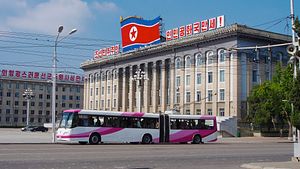The phrase “North Korean bonds” immediately poses the question, “Does North Korea issue bonds?”
North Korea’s economy collapsed decades ago. Its credit rating has become meaningless due to extended sanctions by the international community. Moreover, capital and financial transactions with North Korea, as well as financial transactions through third countries, have been virtually impossible from the early 2000s until now. Put simply, there are no reasons to even consider North Korean bonds as an investment tool.
North Korea’s move to open itself up, however, means a shift in people’s perceptions toward one of the most isolated countries in the world. North Korean bonds are not unique in this regard; several reports suggest that there has been a growing interest in North Korean bonds among portfolio managers worldwide.
Despite its abysmal economy, North Korea did manage to issue some bonds in the past.
First, there was the “People’s Economic Development Bond,” which was issued between 1949 and 1950. The bonds had the national name “Democratic People’s Republic of Korea” written on the top, with the name of the bonds printed below. It is known that the bonds were issued by the North Korean military during the Korean War to secure funds to continue the war. There were 50, 100, and 500 North Korean won bills, the due date of which was October 1, 1960. It is estimated that the issued bonds were worth about 1.5 billion North Korean won, but there is no confirmation that North Korea paid the money back to its creditors in 1960 or whether it extended the maturity.
In addition to the People’s Economic Development Bond, there are other bonds officially issued by the North Korean government. Another round, dubbed as the “People’s Livelihood Bond,” was issued from May to November 2003. These bonds were issued as part of the “July 1 Economic Management Improvement Measures” implemented by the former North Korean leader Kim Jong Il. The bonds were issued to the North Korean people, and there were 500, 1,000, and 5,000 North Korean won bills. The maturity date was reputed to be 10 years after the initial issue, but it is also not known whether repayment was made at maturity.
The tricky part is that making investments and transactions in the two types of North Korean bonds mentioned above is impossible outside of North Korea, as engaging in such activities is a violation of sanctions by the international community.
Then why do some media organizations and financial institutions keep referring to them as an investment tool? This is because they fail to distinguish the difference between “North Korean bonds” and “derivatives which have some assets and intangible rights in relation to North Korean underlying assets.”
Here is the story. Around 140 banks from 30 countries lent money to North Korea in the 1970s, which Pyongyang failed to repay. Later in 1987, creditors attempted to seize North Korea-related assets, but it was unknown whether this attempt was successful at the time.
It finally became clear that the banks were unable to get their money back from North Korea, at which stage a French bank BNP Paribas bought in 1997 “rights to collect debts from North Korea” from several banks that lent money to the North. The French bank later launched derivatives bonds using these rights as the underlying assets, labelling it as “NK Debt Corporation.”
Apart from BNP Paribas, a few international financial institutions have repackaged North Korea’s debt into tradable products. This means when someone talks about North Korean bonds that can be traded and invested on the international market without violating sanctions, they are referring to these repackaged products, not actual North Korean bonds.
Despite rising expectations and interests, such products have been proven to be not ideal for investment.
For instance, the price of BNP Paribas’ $1 (100 cent) product stood at 0.765 cents as of April 12. This indicates that the value has plummeted by 99.24 percent. The price briefly reached 20 cents and 26 cents in 2000 and 2007 respectively, when the first and second inter-Korean summits were held, but since then, it has dropped significantly.
Will North Korea be able to issue tradable bonds on international markets in the future? That depends on whether or not the international sanctions against Pyongyang will be lifted. Time will tell.
































